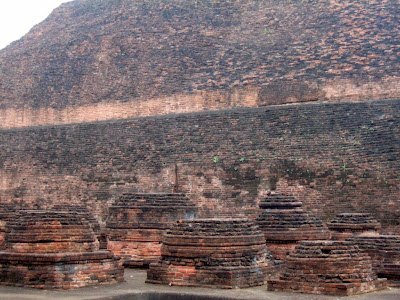
The ancient Nalanda University situated in a small village named Bada Gaon, 11 km away north of Rajgir in Bihar State, was the most renowned monastic university in India. It was the world first residential university as it accommodated with dormitories for its students. This oldest ancient higher learning institution was founded by Gupta Kings during the reign of King Sakraditya in 5th century and flourished until 12th century. At its peak, it attracted over 10,000 students with 2000 teachers coming from all parts of the world. Many famous Buddhist scholars like Chinese monk Rev. Xuanzang, had studied and taught here. The University besides religion, covered every field of learning including history, medicine, architecture, laws and many other subjects.



Nalanda University was destroyed by invaders three times and was rebuilt twice. The first destruction occurred in 5th century during the reign of King Skandagupta (455-467) but was restored and further expanded by his successor. The 2nd time was in early 7th century when it was destroyed by Gandas but was again restored in the same period by Bauddha King Harshavardhana (606-648).


The world first residential university faced its final destruction in year 1193, when it was violently destroyed and damaged in a Turkish attack led by Bakhtiyar Khilji who tried to uproot Buddhism. The Muslim leader and his army destroyed the monasteries, ransacked the whole learning center and set a fire to it. It was reported that the grand library and its nine millions manuscripts was burning for three months. Monks were driven away from the site and thousands were burned alive and beheaded.



The immense complex of Nalanda Library was divided into three large buildings, namely Ratnasagara, Ratnadadhi and Ratnaranjaka. Highly sacred manuscripts like Prajnaparamita Sutra and Samajguhya were housed in the one storey high Ratnadadhi Building. Ratnadadhi means ocean of gems.


The Nalanda Library which was also known as Dharmagangawas, was located in a nine storey building structure where copies of texts were produced. It was a place where monks and scholars used to meticulously looked for references, copied books and documents to compile their own collections. Religion manuscripts were covered with cloth, tied up and placed on the iron shelves.


Temple No. 3 at the southern extremity was the most imposing structure in Nalanda Ruins. Many sculptures, stone images, bronze and stucco, murals, copper plates, stone and brick inscriptions, seals were unearthed during the excavation.


It was constructed in seven phases surrounded by a votive of stupas and minor shrines, built at different period and time. The building plan followed the concept of Pancharatna with a central shrine and four subsidiaries in the corners.


Temple No. 3


The main stupa of Sariputta by the side of Temple No. 3, is one of the important heritage in Nalanda ruins. It was built over the existing temple site, by Emperor Ashoka to commemorate this famous disciple of Buddha, when he visited Nalanda to worship Sariputta Chaitya.



Sariputta was the most praised disciple of Buddha and had declared him as a true spiritual son. Sariputta was born and passed away in Nalanda. He attained pari-nirvarna in the village few months before Buddha. As per Buddha's instruction, his relics after cremation was handed over to King Ajatashatri who enshrined the relics in a stupa for followers and devotees to pay respect.



Sariputta getting the permission of Buddha, went back to his native place which was than a Brahmin village, to show his mother a correct path of faith. He finally and successfully converted his mother before he attained nirvana.



Ruins contain monuments and heritages.



Rear part of Temple No. 3



Gathered in front of Temple No. 3 are monks and devotees from all parts of the world. They gathered here to pay homage, to understand the history and to feel the great force of this oldest and largest ancient university.


Being nicknamed as City of Monks, Nalanda attracted millions of Buddhist pilgrims coming here to pay homage to this most renowned ancient monastic learning center of Buddhism.



Many of the artifacts and relics unearthed from the site are displayed at Nalanda Museum lied just short distance in front of the ruins site. The scheme of museum is comparatively rather small and not properly organized, compared to those in China where they kept the valuable heritage treasures like this.



The entrance of Nalanda Museum (photographing inside is strictly prohibited.)



No comments:
Post a Comment